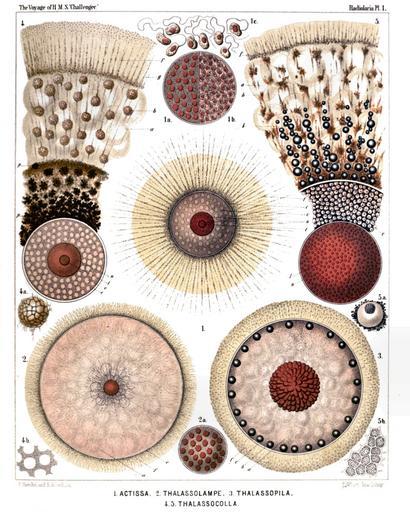MAKE A MEME
View Large Image

| View Original: | Radiolaria_(Challenger)_Plate_001.jpg (2560x3200) | |||
| Download: | Original | Medium | Small | Thumb |
| Courtesy of: | commons.wikimedia.org | More Like This | ||
| Keywords: Radiolaria (Challenger) Plate 001.jpg follows <table> <tr> <td style text-align center; vertical-align top; colspan 3 >Plate 1 Thalassicollida </td> </tr> <tr> <td style font-size 85 ; text-align right; vertical-align top; colspan 3 >Diam </td> </tr> <tr> <td style vertical-align top; >Fig 1 Actissa princeps n sp </td> <td style vertical-align bottom; >×</td> <td style text-align right; vertical-align bottom; >300</td> </tr> <tr> <td style font-size 85 ; padding-left 3em; text-indent -1em; vertical-align top; >The entire living Spumellarium c The spherical central capsule containing finely granulated protoplasm which is radially striated in the cortical zone; v spherical vacuoles enclosed by the protoplasm; n the spherical nucleus in the centre; l the concentric nucleolus; f the radial pseudopodia which pierce the calymma or the yellowish jelly-envelope of the central capsule and arise from the granular sarcomatrix </td> </tr> <tr> <td style font-size 85 ; padding-left 3em; text-indent -1em; vertical-align top; >Fig 1a Half of the central capsule of another specimen in which the original central nucleus is cleft into numerous small nuclei </td> <td style vertical-align bottom; >×</td> <td style text-align right; vertical-align bottom; >400</td> </tr> <tr> <td style font-size 85 ; padding-left 3em; text-indent -1em; vertical-align top; >Fig 1b Half of the central capsule of another specimen filled up by flagellate spores </td> <td style vertical-align bottom; >×</td> <td style text-align right; vertical-align bottom; >400</td> </tr> <tr> <td style font-size 85 ; padding-left 3em; text-indent -1em; vertical-align top; >Fig 1c Eight isolated flagellate spores </td> <td style vertical-align bottom; >×</td> <td style text-align right; vertical-align bottom; >800</td> </tr> <tr> <td style vertical-align top; >Fig 2 Thalassolampe maxima n sp </td> <td style vertical-align bottom; >×</td> <td style text-align right; vertical-align bottom; >8</td> </tr> <tr> <td style font-size 85 ; padding-left 3em; text-indent -1em; vertical-align top; >The entire living Spumellarium c The big spherical central capsule; a the large alveoles filling the central capsule and surrounding a central nucleus; f the pseudopodia piercing the extracapsular calymma </td> </tr> <tr> <td style font-size 85 ; padding-left 3em; text-indent -1em; vertical-align top; >Fig 2a The nucleus alone with numerous nucleoli </td> <td style vertical-align bottom; >×</td> <td style text-align right; vertical-align bottom; >30</td> </tr> <tr> <td style vertical-align top; >Fig 3 Thalassopila cladococcus n sp </td> <td style vertical-align bottom; >×</td> <td style text-align right; vertical-align bottom; >20</td> </tr> <tr> <td style font-size 85 ; padding-left 3em; text-indent -1em; vertical-align top; >c The big central capsule; a numerous large alveoles contained in the central capsule; k oil globules many of which are placed in the radially striped cortical zone; the nucleus placed centrally is covered with numerous radial apophyses or cæcal sacs f The radially striped calymma </td> </tr> <tr> <td style vertical-align top; >Fig 4 Thalassicolla maculata n sp </td> <td style vertical-align bottom; >×</td> <td style text-align right; vertical-align bottom; >100</td> </tr> <tr> <td style font-size 85 ; padding-left 3em; text-indent -1em; vertical-align top; >c The central capsule; v vacuoles filling this capsule; n the central nucleus; l the concentric nucleolus; g the voluminous calymma a small radial piece of which is only represented; a the large alveoles; b peculiar exoplasmatic bodies; p black pigment in the inner zone; f the retracted pseudopodia in the outer zone </td> </tr> <tr> <td style font-size 85 ; padding-left 3em; text-indent -1em; vertical-align top; >Fig 4a An exoplasmatic body </td> <td style vertical-align bottom; >×</td> <td style text-align right; vertical-align bottom; >300</td> </tr> <tr> <td style font-size 85 ; padding-left 3em; text-indent -1em; vertical-align top; >Fig 4b Vacuoles in the endoplasm </td> <td style vertical-align bottom; >×</td> <td style text-align right; vertical-align bottom; >300</td> </tr> <tr> <td style vertical-align top; >Fig 5 Thalassicolla melacapsa n sp </td> <td style vertical-align bottom; >×</td> <td style text-align right; vertical-align bottom; >300</td> </tr> <tr> <td style font-size 85 ; padding-left 3em; text-indent -1em; vertical-align top; >n The large nucleus; l numerous small nucleoli inside the nucleus; v the vacuoles filling up the central capsule and separated by black pigment; a large alveoles in the calymma; k oil globules; b exoplasmatic bodies; f the retracted pseudopodia in the outer zone of the calymma </td> </tr> <tr> <td style font-size 85 ; padding-left 3em; text-indent -1em; vertical-align top; >Fig 5a An endoplasmatic vacuole resembling a cell </td> <td style vertical-align bottom; >×</td> <td style text-align right; vertical-align bottom; >600</td> </tr> <tr> <td style font-size 85 ; padding-left 3em; text-indent -1em; vertical-align top; >Fig 5b A piece of the central capsule </td> <td style vertical-align bottom; >×</td> <td style text-align right; vertical-align bottom; >600</td> </tr> </table> https //archive org/details/reportonradiolar00haecrich 1887 Ernst Haeckel 18341919 ; engravings by Adolf Giltsch 1852-1911 PD-old-auto-1923 1919 Report on the Radiolaria | ||||